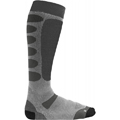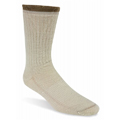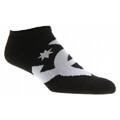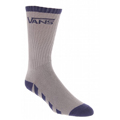
Whether walking, hiking, skiing, or just hanging out, socks can make or break your experience. Cushioning, moisture wicking properties, a good fit and temperature regulation are a few things to keep in mind when shopping around for socks. Once you try out a technical sock with a perfect fit, it’s tough to go back to straight cotton! The House has a large selection of men’s socks andwomen’s socks for every aspiration.
Socks are often categorized by activity or sport to make it easier for consumers to decipher between materials, intended uses, and levels of cushioning. Of course there is some crossover within every category, but understanding design features is the first step in finding the right pair of socks!
 Ski and Snowboard Socks – These socks sit higher than other socks, hitting just below the knee. They won’t ride down your legs and provide cushioning in the shin, arch and ankle. Ski and snowboard socks wick away moisture with either synthetic materials or merino wool.
Ski and Snowboard Socks – These socks sit higher than other socks, hitting just below the knee. They won’t ride down your legs and provide cushioning in the shin, arch and ankle. Ski and snowboard socks wick away moisture with either synthetic materials or merino wool.
Hiking Socks – Hiking socks provide cushioning in the ball and forefoot, while wicking away moisture and drawing it outside the sock. The extra padding is ideal for long treks where blisters or hot spots are likely. Hiking socks also will stay put for hours on end! They come in a variety of heights and typically two weights – lightweight and mid weight.
 Skateboarding Socks - With a variety of colors, heights and logos, skateboarding socks are the economical answer for everyday wear for the younger generation. They’re typically made from cotton and will serve their purpose throughout the school year and beyond.
Skateboarding Socks - With a variety of colors, heights and logos, skateboarding socks are the economical answer for everyday wear for the younger generation. They’re typically made from cotton and will serve their purpose throughout the school year and beyond.
 Casual Socks – Sitting right between a technical sock and a cotton sock, casual socks are usually a blend of cotton and synthetic materials. While not quite as efficient at wicking moisture as a hiking sock, casual socks will stay drier and warmer than an all cotton sock. Prints, colors and varying heights are common among casual socks.
Casual Socks – Sitting right between a technical sock and a cotton sock, casual socks are usually a blend of cotton and synthetic materials. While not quite as efficient at wicking moisture as a hiking sock, casual socks will stay drier and warmer than an all cotton sock. Prints, colors and varying heights are common among casual socks.
 Skateboarding Socks - With a variety of colors, heights and logos, skateboarding socks are the economical answer for everyday wear for the younger generation. They’re typically made from cotton and will serve their purpose throughout the school year and beyond.
Skateboarding Socks - With a variety of colors, heights and logos, skateboarding socks are the economical answer for everyday wear for the younger generation. They’re typically made from cotton and will serve their purpose throughout the school year and beyond. Casual Socks – Sitting right between a technical sock and a cotton sock, casual socks are usually a blend of cotton and synthetic materials. While not quite as efficient at wicking moisture as a hiking sock, casual socks will stay drier and warmer than an all cotton sock. Prints, colors and varying heights are common among casual socks.
Casual Socks – Sitting right between a technical sock and a cotton sock, casual socks are usually a blend of cotton and synthetic materials. While not quite as efficient at wicking moisture as a hiking sock, casual socks will stay drier and warmer than an all cotton sock. Prints, colors and varying heights are common among casual socks.Sock Materials
Merino Wool - If your feet tend to get cold, hot, clammy or sweaty, wool socks will be your best friend. Merino wool is comprised of long, fine, itch-free fibers that have replaced lower end wool found in Grandma’s sweater. Merino wool is the ideal temperature regulating fiber that keeps your feet warm when you’re walking to class and dry in the midst of a heat wave. Perfect for the summer or winter, merino wool also absorbs moisture and passes it through to the outside of the sock.
Synthetic - Synthetic materials like polyester wicks moisture and dries quickly. Other synthetics like nylon and spandex help socks retain their shape, provide a snug fit and add arch support. With a variety of synthetic blends on the market at reasonable prices, synthetic sock materials have gained much popularity over the years.
Ingeo – Ingeo is an eco-friendly synthetic fiber derived from corn that yields outstanding moisture management properties, breathability, insulation and comfort. It’s hypoallergenic, so ingeo is a great alternative for those allergic to wool.
Cotton – Cotton socks absorb moisture and dry slowly, which can lead to blisters when used for athletic activities. However, cotton socks are inexpensive and come in a variety of colors and patterns that aren’t not available in technical socks. They’re ideal for kids, teens, and anyone else who doesn’t need moisture wicking properties for everyday use.
Synthetic - Synthetic materials like polyester wicks moisture and dries quickly. Other synthetics like nylon and spandex help socks retain their shape, provide a snug fit and add arch support. With a variety of synthetic blends on the market at reasonable prices, synthetic sock materials have gained much popularity over the years.
Ingeo – Ingeo is an eco-friendly synthetic fiber derived from corn that yields outstanding moisture management properties, breathability, insulation and comfort. It’s hypoallergenic, so ingeo is a great alternative for those allergic to wool.
Cotton – Cotton socks absorb moisture and dry slowly, which can lead to blisters when used for athletic activities. However, cotton socks are inexpensive and come in a variety of colors and patterns that aren’t not available in technical socks. They’re ideal for kids, teens, and anyone else who doesn’t need moisture wicking properties for everyday use.
Related posts:
No comments:
Post a Comment